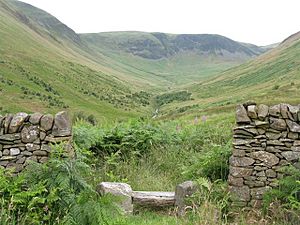Carrifran Wildwood facts for kids
The Carrifran Wildwood is an amazing project by the Borders Forest Trust (BFT). It's all about bringing back native forests and the animals that live there. This special place is called Carrifran, a beautiful valley (or glen) northeast of Moffat in the Moffat Hills. These hills are part of the Southern Uplands of Scotland. The goal is to let nature take over and create a wild, healthy forest again.
Contents
How the Wildwood Began
The idea for the Carrifran Wildwood started in 1993. Some people from a group called Peeblesshire Environmental Concern had a big dream. They wanted to restore a whole river valley, making it look like it did before farming changed the land.
In 1995, the Wildwood Group was formed to make this dream happen. Then, in 1996, this group officially became the Borders Forest Trust (BFT).
Funding the Project
Buying the land for Carrifran Wildwood was a huge step. The project needed almost £400,000 to buy 1,500 acres. What's really cool is that no government money was used. All the funds came from kind people and charities who believed in the project.
On January 1, 2000, the land was officially bought. On that very same day, the first trees were planted!
Planting the Trees
Over the first 10 years, more than 500,000 trees and shrubs were planted. These were carefully chosen native species. Most of this work was done by special contractors.
Even today, thousands of trees are still planted every year. Volunteers from the Borders Forest Trust help with this. They often plant trees around the edges of the valley.
What's Happening Now at Carrifran
Most of the main planting in the valley is now complete. It will take many years for the forest to grow fully. But even so, lots of exciting changes are already happening!
Animals Returning
Many animals are making Carrifran their home again. You can often see foxes and badgers. Otters, stoats, and weasels are also living there.
Birds of prey like kestrels, buzzards, peregrine falcons, and ravens are seen regularly. Sometimes, you might even spot owls, like short-eared, long-eared, and barn owls.
Bird Populations Growing
There are many more willow warblers and chaffinches now. Other woodland birds are slowly moving in too. These include blackcaps, long-tailed tits, siskins, lesser redpolls, reed buntings, and tree pipits.
Ring ouzels visit sometimes, and black grouse have kept a good population. Recently, eight male black grouse were regularly seen displaying their feathers!
The Name Carrifran
The name 'Carrifran' has an interesting history. The last part of the name, 'fran', likely comes from an old language called Cumbric. It probably means 'raven'. Other nearby places also have names that support this idea.
The word 'caer' means 'fort'. So, 'Caer-y-fran' is often suggested as the original name. This would mean 'Fort of the Raven'.
Special Stories from Carrifran
A book called The Carrifran Wildwood Story: Ecological Restoration from the Grass Roots was published in 2009. It was written by Myrtle and Philip Ashmole. They were very important people in starting and developing the wildwood. The book tells the whole story, from the first idea to what the future might hold.
The Survivor Rowan Tree
One very special tree at Carrifran is called the 'Survivor Rowan'. It's a type of tree known as Sorbus aucuparia. This tree was one of the very few trees left in the valley before the restoration project began. It literally "survived" all the changes over the years.
In 2020, the Survivor Rowan was voted Scotland's Tree of the Year! This award goes to amazing trees chosen by the public. The Survivor Rowan then competed in the 'European Tree of the Year' competition in 2021, where it placed 11th.


